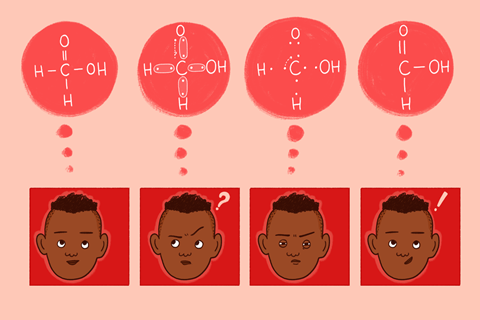How to support pupils to dismantle their existing ideas – and avoid misconceptions
Pupils come to science lessons with a whole host of ideas about how the world works. It’s human nature to try to explain what we see around us, and from their earliest years your pupils have been formulating ideas. These may be from their parents or friends, something they’ve seen on TV, or their own thoughts about how things work.
This habit should be applauded, it’s what makes us inquisitive beings and it’s also likely to be why your pupils are excited by science and the opportunity to learn more about the world. However, not all preconceptions will be correct. Some will be misconceptions and pupils will need support to shift these and replace them with more scientifically accurate ideas.
The first step to overcoming misconceptions is to find out the ideas your pupils already hold. This isn’t always easy.

Misconceptions are normal
Pupils need to feel comfortable to share their thinking and should understand that everyone holds misconceptions – even scientists and teachers. In fact, the process of students adapting and refining their thinking is akin to the process of scientific discovery itself.
If people never changed what they thought, Albert Einstein would have been ignored in the early 1900s and physics would have stayed using Newtonian mechanics to explain the movement of objects. Physicists, however, were led by the evidence and developed their thinking as new information became available. We should encourage our pupils to do the same.
There is much then that we can learn from the process of scientific discovery when dealing with pupil misconceptions. Misconceptions are part of the history of science and we all have them!
The key things are to be aware of misconceptions your pupils are likely to hold and ways of overcoming them. To adjust their misconceptions, pupils are likely to need to see compelling evidence that helps them change their thinking and accept the new idea – changing thinking takes time and pupils are likely to need to revisit things and to see different examples to help develop their thinking.
7 simple rules to boost science teaching
Click to expand and explore the rules
Build on the ideas that pupils bring to lessons
Help pupils direct their own learning
Use models to support understanding
Support pupils to retain and retrieve knowledge
- Pay attention to cognitive load—structure tasks to limit the amount of new information pupils need to process
- Revisit knowledge after a gap to help pupils retain it in their long-term memory
- Provide opportunities for pupils to retrieve the knowledge that they have previously learnt
- Encourage pupils to elaborate on what they have learnt
Use practical work purposefully and as part of a learning sequence
Develop scientific vocabulary and support pupils to read and write about science
Use structured feedback to move on pupils’ thinking
What ideas pupils bring to lessons
If only we could see inside their minds to understand what’s really going on when they’re answering a question! Unfortunately we can’t. Therefore, we need to ensure our classroom interactions provide us with the knowledge we need about the thought processes of our pupils.
Sometimes it can appear pupils understand a concept and are answering a question correctly. However, on further discussion their misconceptions can become clear, which is why it’s important to address ideas in multiple different ways.
Two ways to make pupil thinking explicit are diagnostic questions and well-structured classroom discussion.
Diagnostic questions are carefully designed multiple choice questions, with the distractors designed to uncover specific misconceptions. These can be particularly useful for directing teacher effort in a class, showing whether some areas need to be taught to the whole class, or if some small group or individual targeting is required. You can also use diagnostic questions to follow a misconception to resolution, although it’s always worth rechecking after a forgetting gap as misconceptions can be persistent. BEST offers plenty of diagnostic question materials.
Encouraging high-quality classroom talk is also a good way of finding out what pupils are thinking. Using frameworks to help structure classroom talk can be helpful, and one particularly useful structure is argumentation. This helps pupils to understand what we know, but also importantly why we know it. Pupils are encouraged to use data, warrants (statements that link data to claims) and rebuttals of counterarguments. This structure means pupils can discuss both scientifically accurate ideas and misconceptions, with the structure leading them to understand why any misconceptions aren’t supported by evidence.
Support your pupils to understand the value of sharing their current thinking and talking through ideas. Make this part of your classroom culture. Pupils should also understand that changing thinking based on evidence is part of being a scientist and, rather than being something to keep hidden, is instead something to be celebrated.
This article is part of the series 7 simple rules for science teaching, developed in response to the EEF’s Improving secondary science guidance. It supports rule 1a, Understand the preconceptions that pupils bring to science lessons.
Downloads
Dissolving and disappearing
Word, Size 1.2 mbDissolving and disappearing
PDF, Size 0.11 mb










2 readers' comments